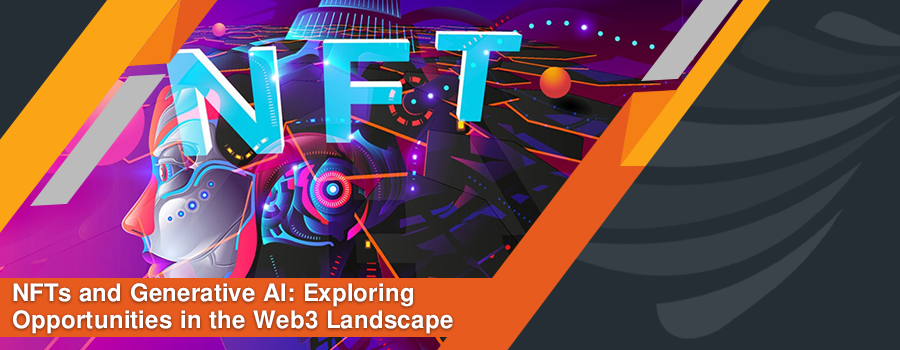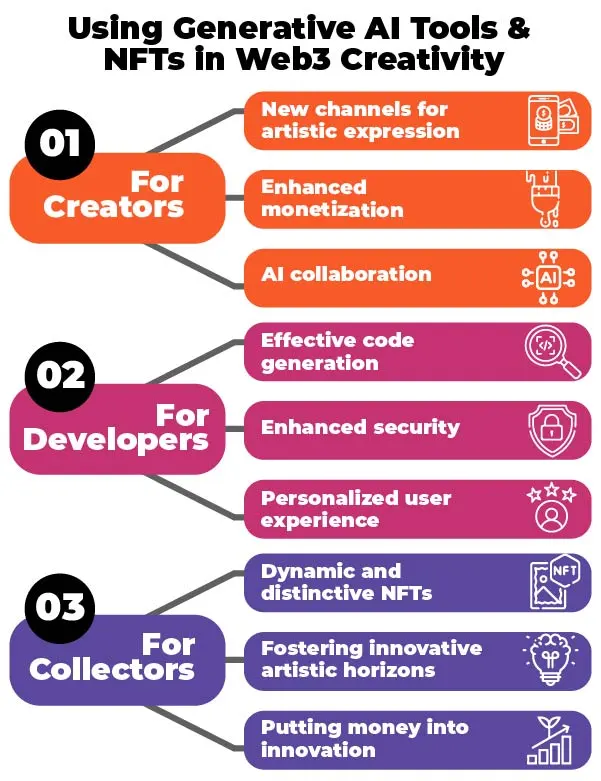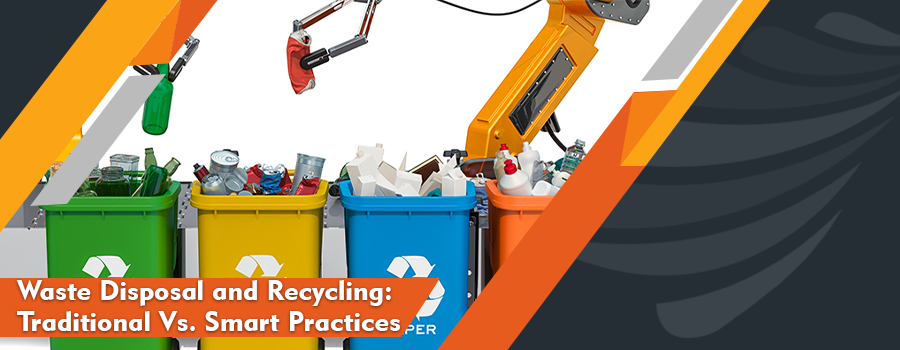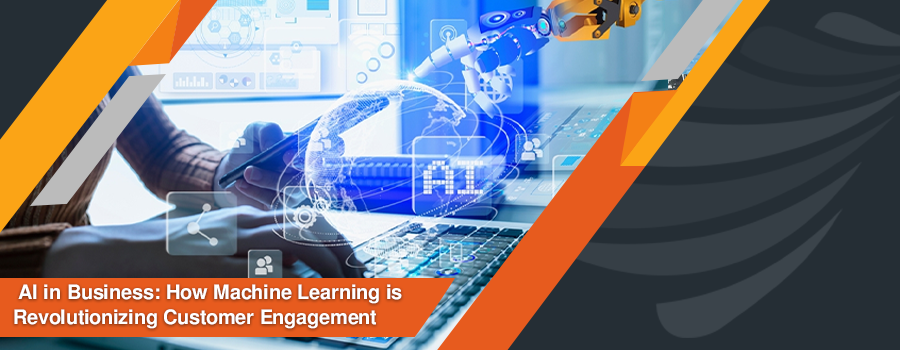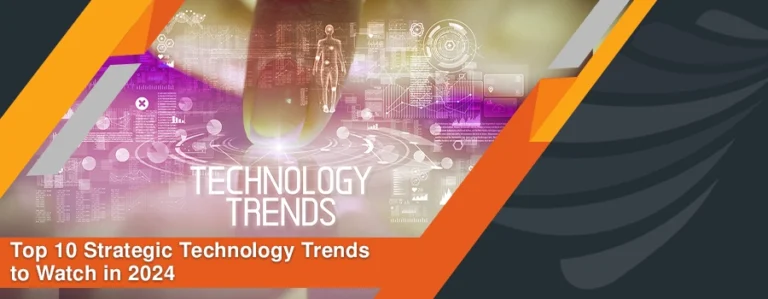NFTs are the distinctive passports for digital assets in the Web3 era, each with its backstory. Generative AI is the tech magician creating unique works of art using digital magic. Both are rewriting the rules of innovation and ownership together. Imagine a day you could safely own and exchange digital passports to trade your music, artwork, or even virtual real estate. A single click and a few lines of code can unlock a universe of possibilities parallel to a digital revolution where pixels and algorithms collide.
We welcome you here to explore how NFTs and generative AI work in the Web3 digital landscape and bring new opportunities.
What are NFTs?
Non-fungible tokens, or NFTs, are digital assets that showcase the proof of authenticity of a specific piece of content via blockchain technology. Unlike fungible assets like cryptocurrency, which can interchange with each other and have the same value, NFTs are inseparable and distinct. Most NFTs are part of the Ethereum blockchain, and many other blockchains have implied their versions of NFTs. Ethereum is a cryptocurrency like a dogecoin or bitcoin, but its blockchain keeps track of who trades and holds NFTs.
What is Web3?
Web3, the next iteration of the internet, is categorized by user-centric, interoperable (technology that allows diverse systems to interact with minimal human involvement), and decentralized (network where control is distributed among multiple nodes) systems built on blockchain and other decentralized technologies. The change from Web1 to Web3 highlights the rapid transformation of interaction and how users interact digitally.
What is Generative AI?
Generative AI refers to deep learning models that can produce high-quality images, text, and related content based on the data they were trained on. These models demonstrate the capacity to develop unique and varied outputs based on the patterns and information they’ve learned during training. They use complex algorithms and neural networks to generate material that wasn’t explicitly coded into them.
The Intersection of NFTs and Web3
The intersection of NFTs and Web3 reflects technological convergence that redefines digital experience, decentralization, and ownership. The details of how this intersection contributes are presented below:
1. Digital Ownership
Web3 allows you to manage your digital experience, whereas NFTs guarantee the authenticity of assets. Therefore, both Web3 and NFTs serve the idea of digital ownership. In other words, NFTs give consumers more control over their online presence by redefining digital identity and ownership ideas in Web3 contexts.
2. Tokenization of Assets
By smoothly integrating physical assets into the Web3 economy, NFTs are leading a dramatic change in the tokenization of physical assets. This revolutionary integration makes real-world assets unparalleled, liquid, and accessible, fragmenting ownership and enabling worldwide participation in investment possibilities. Beyond conventional financial boundaries, NFTs give these tokenized assets programmability, allowing for automated compliance, open governance, and effective revenue distribution via smart contracts.
3. Cross-Platform Interaction
NFTs are interoperable, so users can easily switch between different Web3 platforms. The Web3 ecosystem supports this cross-platform interaction, making it easy for users to trade and access NFTs.
For example, through interoperable platforms or bridges, an NFT produced on Ethereum can be connected to the Binance Smart Chain and vice versa, increasing the NFTs’ liquidity and accessibility for users across other blockchain networks.
4. Empowering Decentralized Finance (DeFi):
Tokenized real-world assets support the expansion of DeFi by offering collateral options and expanding the variety of assets available for lending, borrowing, and other decentralized financial operations.
SFor instance, consider a scenario where real estate assets are tokenized as NFTs and integrated into the DeFi ecosystem. These tokenized real estate NFTs can be used as collateral for decentralized loans or liquidity provision in decentralized lending platforms. Investors who hold these NFTs can leverage them to borrow funds or earn interest by supplying liquidity to DeFi protocols.
5. Fractional Ownership and Micro-Investing
Through the ability to own a share of high-value assets, NFTs enable fractional ownership, opening investing to a wider audience. This supports the idea of micro-investing, in which small amounts of capital are required for participation by individuals.
sFor example, think of tokenizing a valuable digital artwork as an NFT. Investors can jointly own shares of this artwork through fractional ownership made possible by NFTs, with each investor representing a portion of the NFT. As a result, more people can participate in the art market and buy and co-own prestigious digital assets with less money.
6. Smart Contracts and Programmable Assets
NFTs are crucial in the emerging metaverse, where users can transfer digital assets across virtual environments. This elevates user experience and plays a role in developing shared virtual space. Smart contracts linked with NFTs allow personalized and context-aware experiences, adjusting functionality and content based on user choice and particular conditions. To further understand, consider a content creator who creates limited edition digital collectibles as NFTs.
Every NFT in the series stands for a distinct media work, such as unreleased music, artwork, or virtual goods. By selling these NFTs directly to their audience, the inventor can profit from them. In the NFTs, the maker can also include unique benefits or privileges, such as access to private events, behind-the-scenes videos, or virtual interactions. In addition to buying these NFTs as a kind of ownership, fans, and collectors do so because of the exclusive opportunities and advantages they provide.
The Intersection of Generative AI and Web3
The intersection of generative AI and Web3 brings numerous opportunities; some of the most promising are:
1. AI-Driven Decentralized Decision-Making in Web3
AI technologies are a major factor in how the Web3 environment changes decentralized decision-making dynamics. Decentralized applications (dApps) can increase efficiency and accuracy by making intelligent judgments independently, without human interaction, and through autonomous data analysis. AI-driven decentralized decision-making can maximize results and streamline finance, supply chain management, and healthcare procedures. This has profound ramifications for these sectors.
2. AI-Enabled Personalized User Experiences in Web3
Using algorithms to examine user behavior and preferences, AI creates a paradigm change in Web3 user experiences. Personalized offerings boost engagement and extend customer retention. AI-driven personalization improves the user experience, making the digital world more responsive and customized.
3. AI’s Role in Web3 Governance and Security
AI impacts both the security and governance of Web3’s decentralized networks. AI algorithms aid in the decision-making process when responding to security issues by helping to detect malicious actors and monitor the network for prospective security threats. By being proactive, this strategy strengthens Web3 ecosystems’ resistance to future threats and vulnerabilities.
4. Web3 Security and AI Advancements
Cybersecurity is one area where Web3 and AI are most clearly convergent. Artificial intelligence (AI)-driven solutions are becoming essential for identifying and stopping fraud on the blockchain. Businesses such as Cyvers.ai, for example, use geometric machine learning for anomaly identification and real-time analysis. Reducing detection windows, dealing with smart contract vulnerabilities, and closing the gap between Web3 and conventional cybersecurity breaches are all future important aspects of Web3 security.
Using Generative AI Tools and NFTs in Web3 Creativity
NFTs and Generative AI tools create an interactive combination in the world of Web3. This opens exciting possibilities for collectors, developers, and creators. The key aspects of this interaction are:
1. For Creators
New channels for artistic expression: By stretching the bounds of traditional art forms, generative AI tools can assist artists in exploring novel styles, mediums, and ideas. Imagine poems written by AI algorithms working on the data of human poets or AI-generated music that changes according to listener preferences.
Enhanced monetization: Creators can establish ownership and scarcity of their generative art by minting it as NFTs, which may result in higher pricing and secondary market royalties. Websites with a focus on generative NFT art include Art Blocks and Fxhash.
AI collaboration: By incorporating unexpected components or variants into their work, artists can employ generative AI to enhance their creative process. This may result in innovative forms of art that combine artificial and human intelligence.
2. For Developers
Effective code generation: AI is used by programs like Jit Codes to produce boilerplate code for smart contracts, which ensures accuracy and saves developers’ time.
Enhanced security: Services like SolidityScan, which uses AI to scan smart contracts for possible flaws, make Web3 applications more secure.
Personalized user experiences: Generative AI can produce a more captivating Web3 experience by adjusting user interfaces and interactions according to personal preferences.
3. For Collectors
Dynamic and distinctive NFTs: Generative art NFTs provide never-before-seen levels of individuality and potential development. A degree of involvement and mystery is added by certain AI-generated NFTs, which alter over time in response to outside variables.
Fostering innovative artistic horizons: Through acquiring AI-generated NFTs, collectors actively participate in the growth of this new medium and promote additional experimentation.
Putting money into innovation: Investing in the future of art and technology through the ownership of generative AI NFTs has the potential to increase in value as both fields advance.
Challenges of Integrating Generative AI Tools and NFTs in Web3 Technology Landscape
There are different challenges that we can consider:
1. Ownership and Copyright
It is imperative to ascertain the ownership and copyright of work artificial intelligence generates. Does the AI come from the artist, the AI itself, or a mix?
2. Transparency and Accessibility
It’s critical to guarantee that all creators can access generative AI technologies. Transparency is also essential for comprehending the data and algorithms utilized to create art.
3. Impact on the Environment
AI model training and operation can consume a lot of energy. Sustainable solutions are required for the ethical application of generative AI in Web3.
Where generative AI and NFTs meet in Web 3, there is much room for innovation, disruption, and creative expression. Overcoming obstacles and guaranteeing appropriate growth as these technologies advance will shape the future of this fascinating field.
Future Glimpse
As we dig deep into the technological revolution, we can predict immersive outcomes that one could never imagine. We can change the world with the intersection of NFTs, Web3, and generative AI.
1. Immersion Travel Experiences Beyond Boundaries
By combining NFTs, Web3, and generative AI, travel can be redefined and made more comfortable for consumers, who can virtually visit destinations from home. NFTs might represent unique virtual experiences, and generative AI could create realistic environment simulations with previously unheard-of levels of immersion.
2. Endless Creative Possibilities
NFTs of the future will change over time in response to generative AI algorithms and user interactions. These dynamic NFTs can develop into virtual assets or live artworks that adjust to their environment or the user’s preferences.
3. AI-Driven Medical Diagnostics
Medical diagnostics can be improved by combining NFTs for secure data ownership with generative AI tools. Patients may own NFTs and manage their health data, and AI algorithms can use this data to evaluate and offer individualized treatment suggestions and healthcare insights.
4. Immersive Learning Environments
NFTs and generative AI-powered metaverses have the potential to completely transform education. NFTs might represent unique instructional content, and generative AI could produce dynamic, adaptable learning environments. Pupils could participate in immersive learning opportunities customized to fit their learning preferences.
5. New Forms of Social Interaction
Social interaction may be redefined at the nexus of generative AI, NFTs, and Web3. NFTs could provide passports to exclusive social areas, and dynamic venues for events, collaborations, and social gatherings could be created by generative AI.
6. Inclusive Global Economy
The Web3, generative AI, and NFTs may all help create a more inclusive global economy. NFT-powered decentralized finance (DeFi) may break geographical boundaries and allow people worldwide to engage in financial operations.
7. Measures of Environmental Sustainability
Using generative AI algorithms, resource utilization and sustainability initiatives in the metaverse could be maximized. NFTs may stand for environmentally friendly procedures, promoting environmentally sensitive actions and behaviors.
The future of Generative AI, NFTs, and the Web3 promises boundless creativity, discovery, and invention. This pivotal intersection can change entire sectors, improve human experiences, and advance the creation of a more inventive, inclusive, and connected society.
Final Thoughts
The revolutionary interaction between Generative AI, NFTs, and Web3 foreshadows a time when traditional restrictions will no longer limit innovation. This convergence transforms ownership, creativity, and engagement and spreads its transformative influence on various disciplines, such as education and healthcare. The capacity to virtually explore, create, and interact on a decentralized and immersive platform promises a more diverse, connected, and creative world. This opens previously unimaginable possibilities for the upcoming technology revolt.

